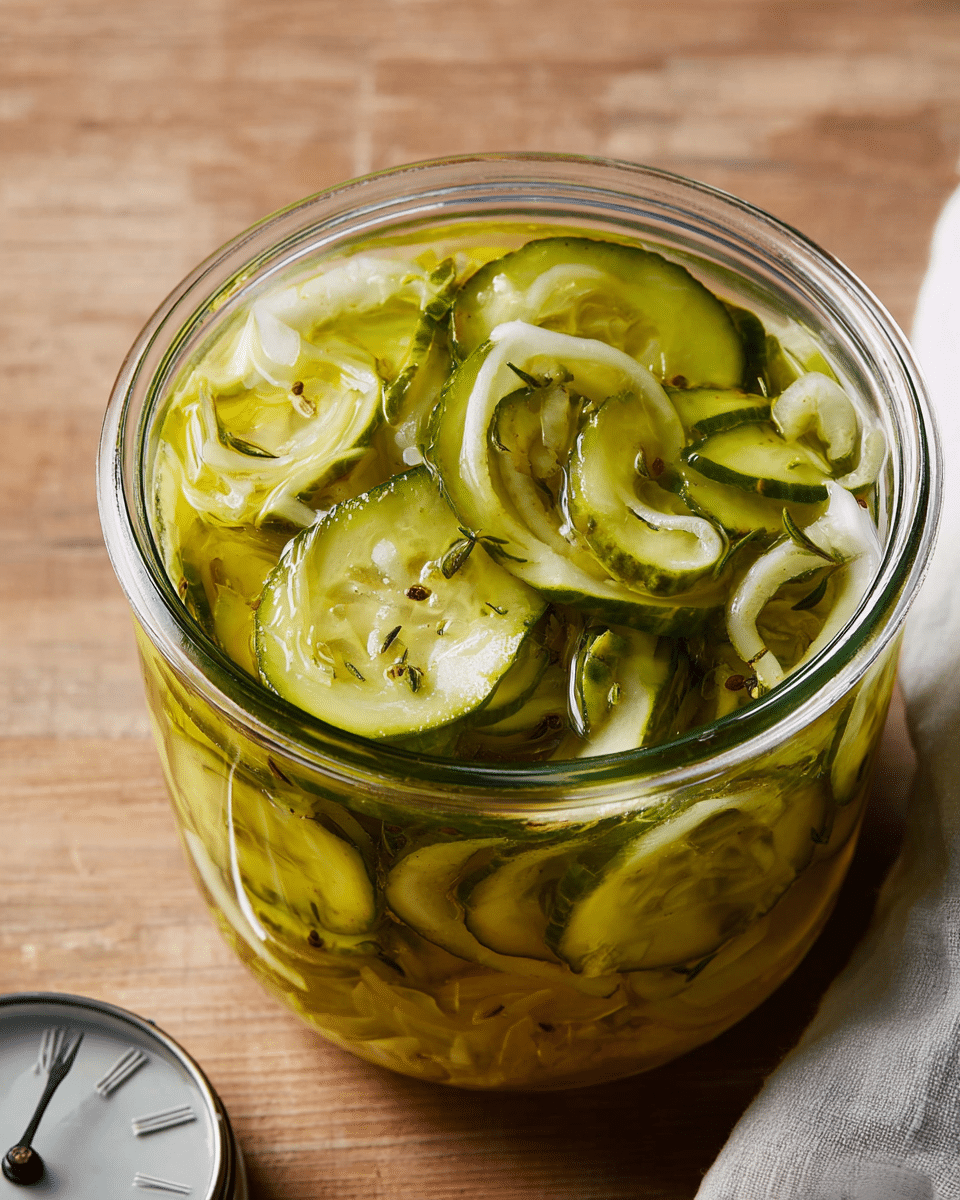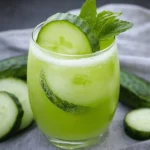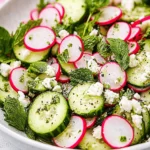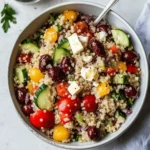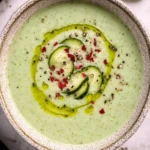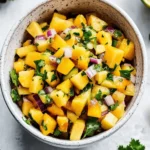Bread and butter pickles are a classic American favorite known for their perfect balance of sweet and tangy flavors. These pickles are typically made with cucumbers, onions, sugar, and a blend of vinegar and spices. Unlike dill pickles, bread and butter pickles offer a milder, slightly sweeter taste that pairs wonderfully with sandwiches, burgers, charcuterie boards, or as a crisp snack right out of the jar.
FULL RECIPE
Ingredients
- 4 cups thinly sliced pickling cucumbers (about 3–4 medium cucumbers)
- 1 medium yellow onion, thinly sliced
- 1 tablespoon kosher salt
- 1 cup granulated sugar
- 1 cup white vinegar
- 1/2 cup apple cider vinegar
- 1/4 cup water
- 1 tablespoon mustard seeds
- 1/2 teaspoon celery seeds
- 1/2 teaspoon ground turmeric
- 1/4 teaspoon crushed red pepper flakes (optional, for a hint of heat)
Directions
- Prep the Cucumbers and Onion: In a large bowl, toss the sliced cucumbers and onion with the kosher salt. Let sit for 10–15 minutes to draw out excess moisture. Rinse thoroughly and drain well.
- Make the Pickling Brine: In a medium saucepan, combine sugar, white vinegar, apple cider vinegar, water, mustard seeds, celery seeds, turmeric, and red pepper flakes (if using). Bring to a simmer over medium heat, stirring until the sugar dissolves completely.
- Combine and Heat: Add the drained cucumber and onion slices to the saucepan. Stir gently and cook for about 5 minutes, just until the cucumbers turn slightly darker and more translucent.
- Cool and Store: Remove from heat. Use tongs or a slotted spoon to pack the pickles into clean jars, then pour the brine over them to cover. Let cool to room temperature.
- Refrigerate: Cover and refrigerate for at least 2 hours before serving. For best flavor and crunch, allow them to chill overnight. These pickles will stay fresh in the refrigerator for up to 2 weeks.
Nutrition Facts
Per Serving (about 1/4 cup):
- Calories: 60
- Total Fat: 0g
- Saturated Fat: 0g
- Cholesterol: 0mg
- Sodium: 340mg
- Total Carbohydrates: 14g
- Dietary Fiber: 1g
- Sugars: 13g
- Protein: 0g
- Vitamin A: 2% DV
- Vitamin C: 4% DV
- Calcium: 1% DV
- Iron: 1% DV
History and Popularity of Bread and Butter Pickles
Bread and butter pickles have long been a staple in American households, especially in the South and Midwest. Their origin is believed to date back to the 1920s when cucumber farmers Omar and Cora Fanning popularized the term “bread and butter” to describe their sweet pickles, which they reportedly traded for groceries. These pickles gained fame for their perfect balance of sweet and tangy flavors, making them a beloved condiment for everything from sandwiches to holiday relish trays. Today, they remain a comfort food favorite and are widely enjoyed across generations.
Flavor Profile and What Sets Them Apart
Unlike the sharp, garlicky bite of dill pickles, bread and butter pickles offer a unique flavor profile that combines sweetness with a mild tang. The sugar in the brine gives them a gentle sweetness, while the vinegar and spices such as mustard seed and turmeric lend a zesty depth. The result is a pickle that’s not too sour, not too sweet, but just right for pairing with rich or savory foods. Their signature yellow hue and mild crunch make them easily recognizable and incredibly satisfying to eat.
Why This Recipe Is Perfect for Beginners
This quick 30-minute recipe is ideal for home cooks who want to make pickles without the time commitment or complexity of traditional canning. It doesn’t require special equipment, sterilized jars, or pressure canners—just a saucepan, some jars, and basic pantry ingredients. The fast-pickling method means you can enjoy the fruits of your labor the very same day. For beginners who might feel intimidated by food preservation techniques, this recipe is a gentle entry point that delivers bold flavor and satisfying results.
Health Benefits of Homemade Pickles
Making pickles at home gives you control over every ingredient, which translates to a healthier product compared to many store-bought options. You can reduce the sugar, avoid artificial preservatives, and limit the sodium content to suit dietary needs. Cucumbers themselves are low in calories and contain antioxidants and hydration-boosting properties. While the brine does include sugar, the overall caloric impact per serving is still minimal. Plus, including pickles in your diet may support digestion thanks to their vinegar content, which has been linked to blood sugar regulation and appetite control.
Perfect Uses and Serving Suggestions
Bread and butter pickles are an incredibly versatile condiment. Their sweet and tangy flavor profile complements savory dishes perfectly. They are a natural topping for burgers, hot dogs, and pulled pork sandwiches. Try layering them into grilled cheese or chicken salad sandwiches for an unexpected burst of flavor. They also shine on charcuterie boards, offering a pleasant contrast to cured meats and cheeses. Even as a simple snack straight from the jar, they provide a crunchy, refreshing bite.
Creative Variations to Try
One of the best parts of making your own pickles is the ability to experiment. You can adjust the sugar levels to suit your taste—either intensifying the sweetness or cutting it down for a sharper bite. Spice lovers can add more crushed red pepper flakes or slices of fresh jalapeño. Swapping white vinegar with rice vinegar or white wine vinegar changes the flavor profile in subtle but interesting ways. You can also try adding whole cloves, cinnamon sticks, or even thin slices of bell peppers for extra aroma and color.
Tips for Achieving Maximum Crispness
A common concern when making quick pickles is preserving their crunch. The key lies in salting the cucumbers and onions before pickling to draw out excess moisture. This step helps them stay crisp after they absorb the brine. Using firm pickling cucumbers rather than standard salad cucumbers is also essential—look for varieties labeled “Kirby” or “pickling cucumbers” for the best results. Avoid overcooking them in the brine, as prolonged heat can soften the texture. A brief simmer of just a few minutes is all that’s needed to infuse them with flavor.
Best Practices for Storage and Shelf Life
Since this is a refrigerator pickle recipe, it doesn’t require traditional canning, but proper storage is still important. Once the pickles have cooled, transfer them to airtight glass jars and store in the refrigerator. They will continue to develop flavor over the first 24 hours and stay fresh for up to two weeks. Always use a clean utensil when serving to avoid introducing bacteria. If the brine appears cloudy or the pickles lose their crunch entirely, it’s best to discard them.
Pairings with Other Dishes and Beverages
Bread and butter pickles can elevate a variety of dishes, from casual cookouts to more refined meals. Their sweet-sour contrast works especially well with fried foods like chicken tenders, fish and chips, or onion rings. They add brightness to heavier fare such as meatloaf, barbecue, and mac and cheese. For beverages, pair them with iced tea, lemonade, or even a crisp lager or cider. Their acidity helps cleanse the palate and balance out richer, fattier dishes.
Advertisement
Eco-Friendly and Budget-Friendly Choice
Making your own pickles is not only satisfying but also cost-effective. Cucumbers are affordable, especially when purchased in-season or in bulk from farmers’ markets. Homemade pickles also reduce waste—use reusable jars, and if you grow cucumbers in your garden, this recipe becomes even more sustainable. The minimal cooking time lowers energy use compared to traditional canning methods. Plus, you’re eliminating excess packaging and plastic waste associated with store-bought options, making this a green kitchen habit worth keeping.
Conclusion
Crisp bread and butter pickles are a delightful blend of tradition, flavor, and simplicity. Whether you’re new to pickling or a seasoned home cook, this 30-minute recipe delivers impressive taste with minimal effort. From their nostalgic charm to their modern kitchen versatility, these pickles embody the best of homemade condiments. Serve them with your favorite meals, gift them to friends, or simply enjoy them straight from the jar—however you use them, they’re sure to become a go-to in your culinary repertoire.

